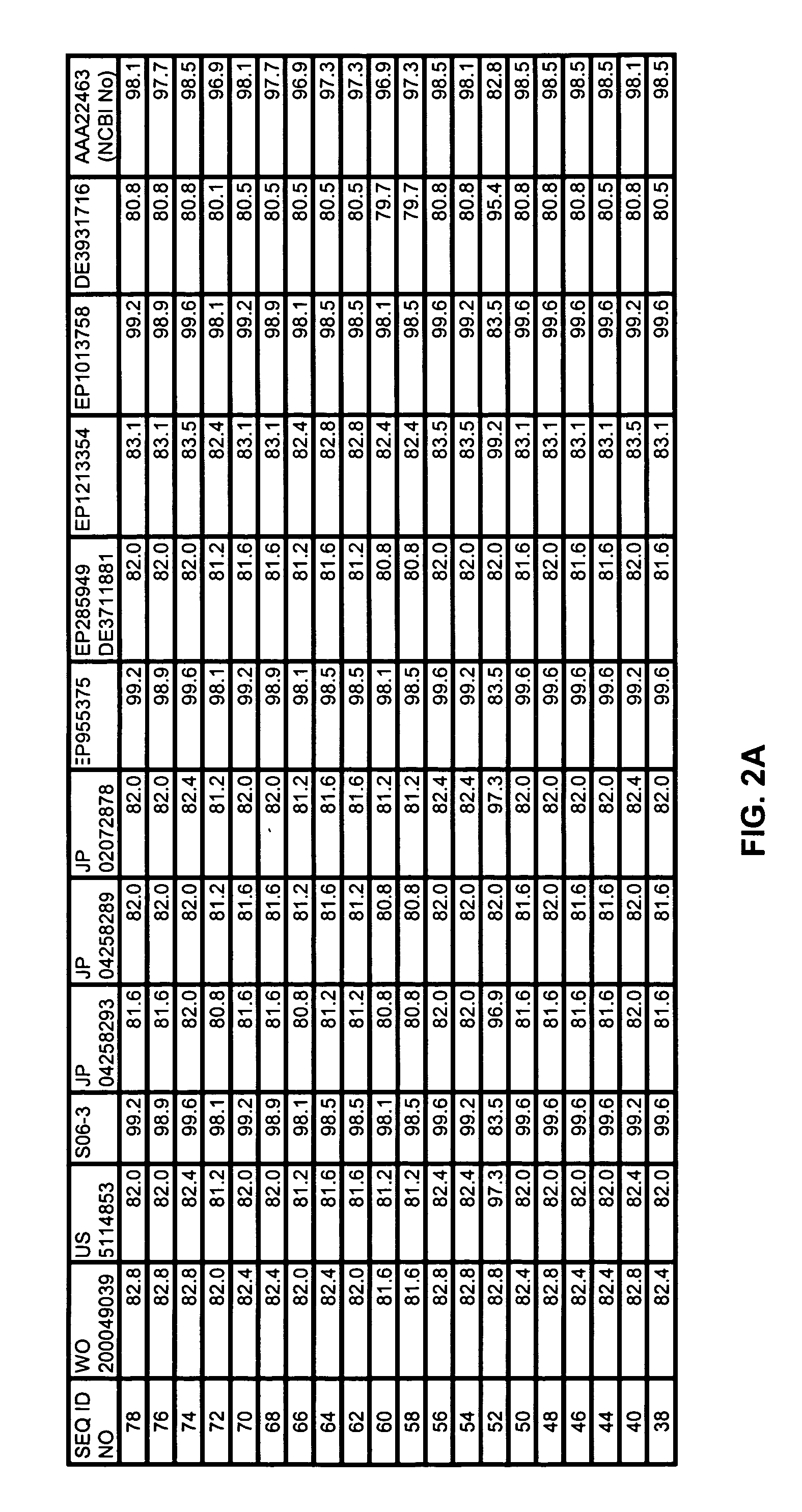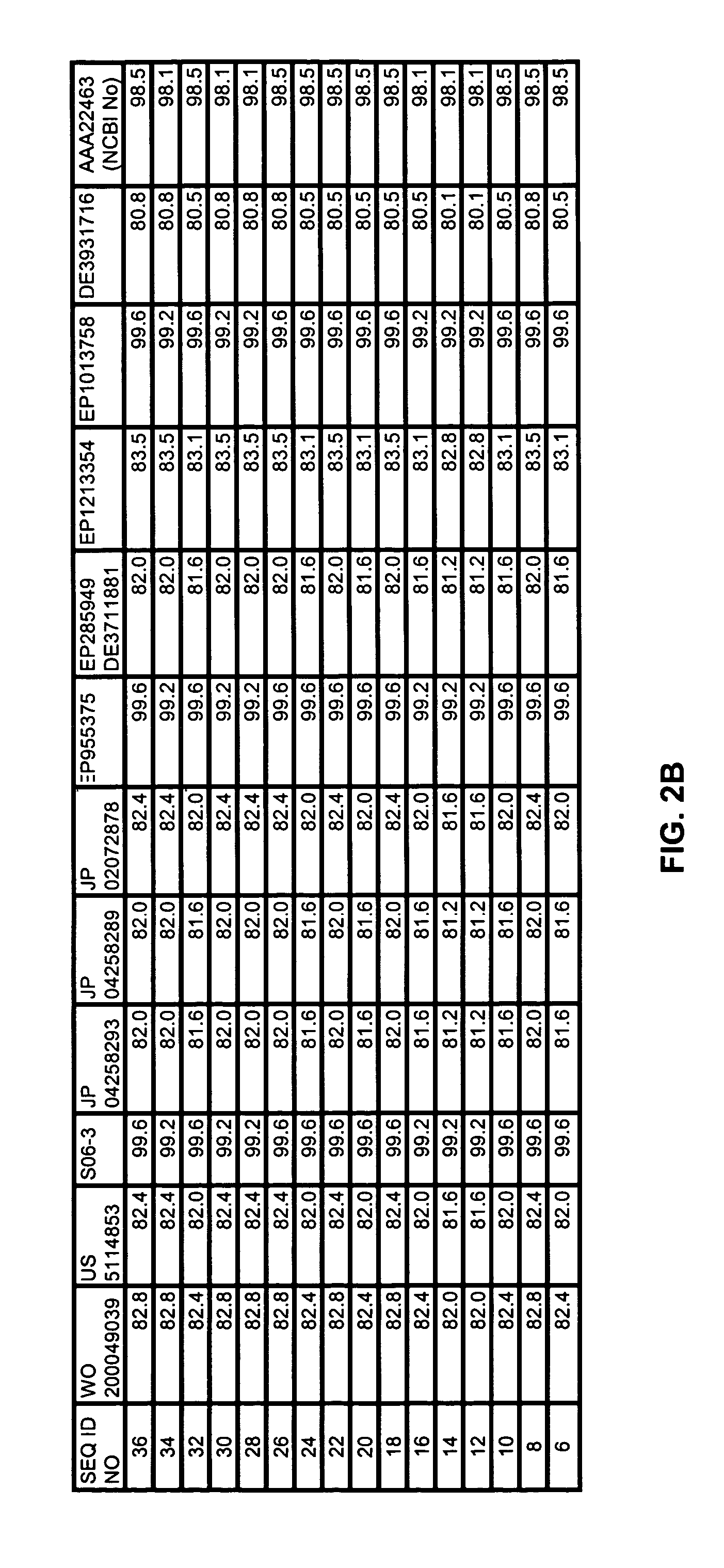Glucose dehydrogenase polypeptides and related polynucleotides
a glucose dehydrogenase and polypeptide technology, applied in the field of enzymology, can solve the problems of limited stability of gdh enzymes, and achieve the effect of enhancing thermostability and enhancing glucose dehydrogenase activity
- Summary
- Abstract
- Description
- Claims
- Application Information
AI Technical Summary
Benefits of technology
Problems solved by technology
Method used
Image
Examples
example 1
Construction of Expression Constructs for Expression of Glucose Dehydrogenase
[0109] The genes for the glucose dehydrogenase were amplified using the polymerase chain reaction (PCR) from genomic DNA preparations of Bacillus subtilis and Bacillus megaterium. The primers for the amplification reactions were designed using the published B. subtilis and B. megaterium glucose dehydrogenase gene sequences, and were as follows:
(SEQ ID NO: 79)B. subtilis forward primer:5′-GAATTCGCCCATATGTATCCGGATTTAAAAGG-3′(SEQ ID NO: 80)B. subtilis reverse primer:5′-TGGCCGGATCGTCATTAAGCGCGGCCTGCCTGGA-3′(SEQ ID NO: 81)B. megaterium forward primer:5′-GAATTGGCGGATATGTATAAAGATTTAGAAGG-3′(SEQ ID NO 82)B. megaterium reverse primer:5′-GGGCGGATCCTCATTATCGGCGTCCTGCTTTGGA-3′
[0110] The PCR products were cloned into an expression vector of FIG. 3 behind a lac promoter under control of the lacI repressor gene, creating plasmids pGDHS06 or pGDHM02. The expression vector contained the P15A origin of replication (P15A o...
example 2
Production of GDH
[0111] In an aerated agitated fermentor, 10.0 L of growth medium containing 0.528 g / L ammonium sulphate, 7.5 g / L of di-potassium hydrogen phosphate trihydrate, 3.7 g / L of potassium dihydrogen phosphate, 2 g / L of Tastone-154 yeast extract, 0.05 g / L ferrous sulphate, and 3 ml / L of a trace element solution containing 2 g / L of calcium chloride dihydrate, 2.2 g / L of zinc sulfate septahydrate, 0.5 g / L manganese sulfate monohydrate, 1 g / L cuprous sulfate heptahydrate, 0.1 g / L sodium borate decahydrate and 0.5 g / L EDTA, was brought to a temperature of 30° C.
[0112] The fermentor was inoculated with a late exponential culture of Escherichia coli W3110 (pGDHS06 or pGDHM02) grown in a shake flask containing LB, 1% glucose (Sigma Chemical Co., St. Louis, Mo.), and 30 μg / ml chloroamphenicol (Sigma Chemical Co., St. Louis, Mo.) to a starting optical density at 600 nm (OD600) of 0.5 to 2.0. The fermentor was agitated at 500-1500 rpm and air was supplied to the fermentation vessel...
example 3
GDH Enzyme Preparation
[0113] The cell paste was washed by suspending 1 volume wet weight of cell paste in 3 volumes of 100 mM Tris / sulfate (pH 7.2) followed by centrifugation at 5000 g for 40 minutes in a Sorval 12 BP. The washed cell paste was suspended in 2 volumes of 100 mM Tris / sulfate (pH 7.2). The intracellular GDH was released from the cells by passing the suspension through a homogenizer in two passes using a pressure of 14,000 psig for the first pass and 8,000 psig for the second pass. The homogenate was centrifuged at 10,000 rpm in a Beckman lab centrifuge for 60 minutes. The supernatant was decanted and dispensed in shallow containers, frozen at −20° C. and lyophilized.
PUM
| Property | Measurement | Unit |
|---|---|---|
| pH | aaaaa | aaaaa |
| nucleic acid sequence | aaaaa | aaaaa |
| glucose dehydrogenase enzyme activity | aaaaa | aaaaa |
Abstract
Description
Claims
Application Information
 Login to View More
Login to View More - R&D
- Intellectual Property
- Life Sciences
- Materials
- Tech Scout
- Unparalleled Data Quality
- Higher Quality Content
- 60% Fewer Hallucinations
Browse by: Latest US Patents, China's latest patents, Technical Efficacy Thesaurus, Application Domain, Technology Topic, Popular Technical Reports.
© 2025 PatSnap. All rights reserved.Legal|Privacy policy|Modern Slavery Act Transparency Statement|Sitemap|About US| Contact US: help@patsnap.com



